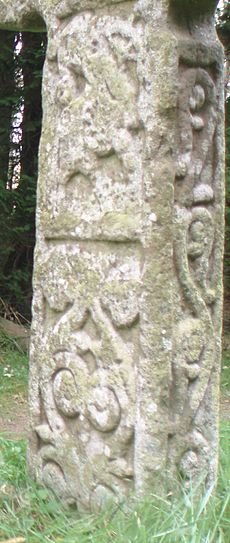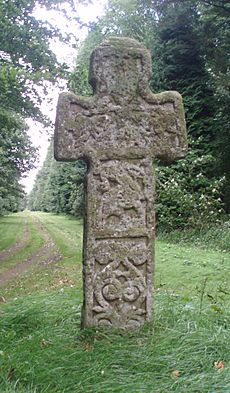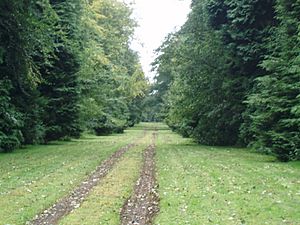Camus Cross facts for kids
Quick facts for kids Camus Cross |
|
|---|---|

The Camus Cross, East face
|
|
| Material | Old Red Sandstone |
| Height | 2 metres (6.6 ft) |
| Symbols |
|
| Created | Tenth Century CE |
| Present location | Camuston Wood, near Carnoustie, Angus, Scotland |
| Coordinates | 56°31′50″N 2°47′01″W / 56.530647°N 2.783570°W |
| Classification | Type III, freestanding cross |
| Culture | Picto-Scottish |
The Camus Cross is an old stone monument in Angus, Scotland. It's also known as the Camuston or Camustane Cross. This tall, carved stone stands on the Panmure Estate near Carnoustie.
It was first written about in the 1400s. People in the 1600s, like Robert Maule, also described it. The Camus Cross is a special type of stone called a freestanding cross. These are rare in eastern Scotland.
Experts believe the cross was made around the 900s (the tenth century). Its carvings show influences from Irish art. There's a popular old story that says the cross marks the grave of a Viking leader named Camus. The story claims King Malcolm II defeated Camus in a battle. However, this battle and the story of Camus are not true historical events.
The name of the cross probably comes from an old village called Camuston. This village no longer exists. Its name comes from old Celtic languages.
Contents
Where is the Camus Cross?
The Camus Cross is in an area called the Downie Hills. It's about 4 kilometers (2.5 miles) northwest of Carnoustie in Angus, Scotland.
The cross stands in the middle of a long path. This path is about 1 kilometer (0.6 miles) long. It leads through Camuston Wood. The path is part of the Panmure Estate.
What Does the Cross Look Like?
The Camus Cross is carved from a type of rock called Old Red Sandstone. It stands about 2 meters (6.5 feet) tall. At its bottom, it's about 0.6 meters (2 feet) wide. At the arms, it's about 0.8 meters (2.6 feet) wide. The stone is about 0.2 meters (0.6 feet) thick.
The cross sits on a small mound of earth. This mound is about 7.5 meters (24.6 feet) wide from east to west. It's 4.5 meters (14.8 feet) wide from north to south. The mound is about 1 meter (3.3 feet) high. The cross faces east to west.
All sides of the cross have carvings. Over time, the stone has been worn down by weather, especially on the west side. This makes some of the designs hard to see.
The Camus Cross does not have the usual Pictish symbols. These symbols are often found on other ancient stones in Scotland. Because it doesn't have these symbols, it's called a Class III stone.
It's rare to find old, freestanding crosses like this one still in good condition. This is because they were easy to damage. The Camus Cross and the Dupplin Cross are two of the few complete ones in eastern Scotland.
Carvings on the West Side
The west side of the cross has three main sections. The top part is very worn. An old writer named Alexander Gordon said in 1726 that this part showed a crucifixion scene. This is a scene showing Jesus on the cross. He said there was a man on the right side, but the left side was too damaged to see.
Below this, there is a carving of a centaur. A centaur is a mythical creature that is half-human and half-horse. This centaur is holding a bow. The lowest part of the west side has a beautiful pattern of plants and leaves. This design is symmetrical, meaning it's the same on both sides.
Carvings on the East Side
The east side of the cross usually shows Christ. He is shown with angels above him. Below them are the four evangelists. These are the writers of the four Gospels in the Bible.
However, Robert Maule, who first described the stone in detail, thought the scene showed Moses giving out the Law.
Art Style and Influences
The carvings on the Camus Cross are very similar to those on the Brechin Hogback stone. This suggests they were influenced by Irish art and religious ideas.
The plant designs on the north and south edges of the cross were once thought to be from the Viking Age. But now, experts believe they are more like Irish art from the late 900s. The way the plant scrolls are carved on the west side also looks very Irish. The figures of people on the east side are just like those on the Brechin Hogback. On the Brechin Hogback, these figures carry items related to early Irish monasteries.
History of the Cross
The Camus Cross is believed to be from the late Pictish or early Gaelic period, around the 10th century. The first time it was mentioned in writing was in 1481. This was in a legal document describing the border between the lands of Camuston and Downy. The document said the border started "from the great stone cross of Camuston."
The cross was also mentioned in a book by Hector Boece in 1527. This book talked about the Battle of Barry. The antiquarian Robert Maule gave the first detailed description of the cross. In 1620, he moved it a few feet to place it in the center of the Camuston Wood path.
The Legend of Camus
There's a well-known story about a Viking leader named Camus. The story says he led a Viking army that was defeated by King Malcolm II at the Battle of Barry. The legend claims that Camus ran away from the battle. He was then caught and killed at the spot where the Camus Cross now stands.
This story became popular in the 1500s because of historian Hector Boece. However, historians today know that this battle and the character of Camus are not real historical events. They are part of folklore.
The Village of Camuston
The name of the cross likely comes from an old village called Camuston. Today, there are no signs of this village. It had disappeared by the time the first detailed maps were made in the late 1800s. An earlier map from 1794 shows its location about half a mile east of the cross.
The village name "Camuston" has old spellings like "Cambistown" from the 1400s. Its name comes from Celtic languages, not Scandinavian languages.
An Old Burial Near the Cross
In 1598, a burial was found near the Camus Cross. Robert Maule believed it was the body of Camus himself. He described finding a grave with large stones around it. Inside were the bones of a very tall man. The thigh bone was said to be almost as long as the lower leg and thigh bone of a normal man today. The skull was large and had a missing piece, which looked like a sword had struck it.
Not much more is known about this burial. However, items found in the stone coffin were kept at Brechin Castle. These items were later sketched and looked like artifacts from the Bronze Age. Bronze Age items are often found in this area.





